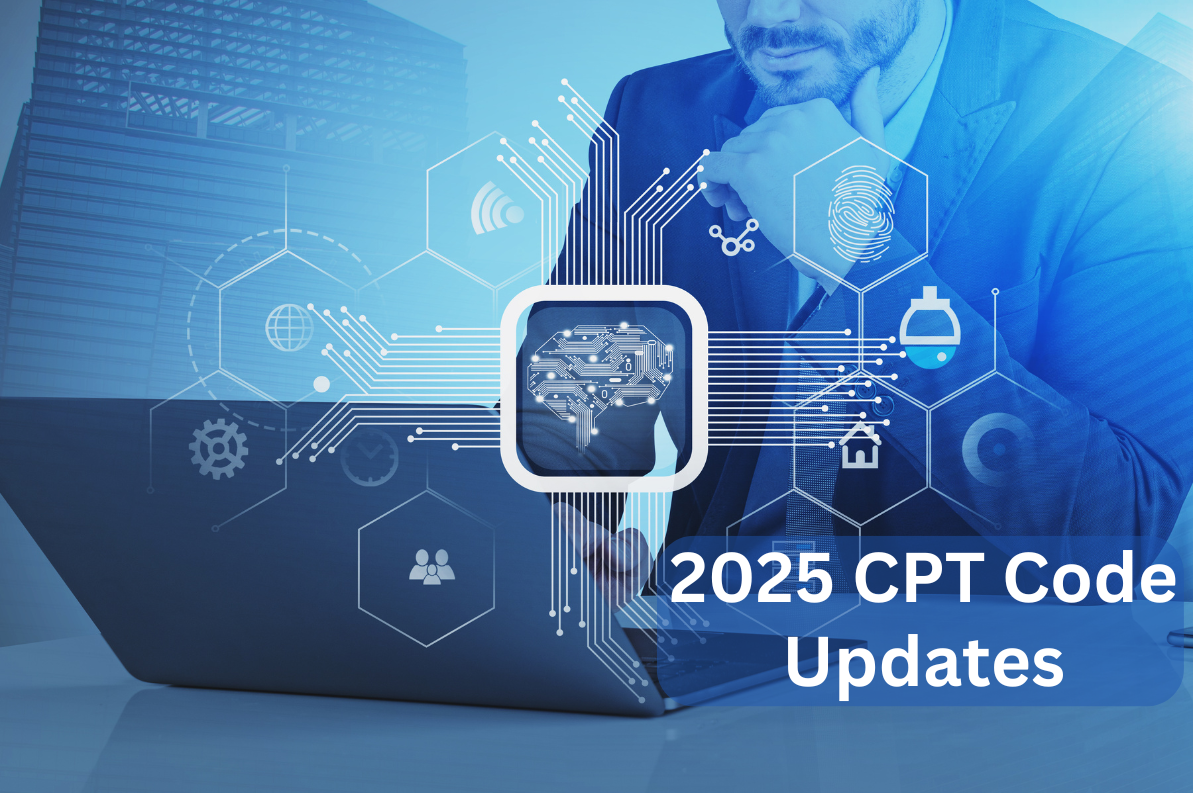The CPT code system, also known as the language of medicine, will be updated many times in 2025. As a provider of medical coding services, we stay current with these changes to assure accuracy and compliance.
The AMA’s new edition, which contains 420 updates for 2025, adds to the more than 11,000 CPT codes in use today. The updates include 270 new codes, 112 removals, and 38 revisions. One key feature of the new code set is that it aims to help physicians keep pace with new healthcare innovations and technologies.
2025 CPT Code Updates
CPT code changes that will take effect in 2025 include:
AI Taxonomy
The CPT AI Taxonomy, introduced in 2023, has been further implemented in 2025 to classify augmented intelligence (AI) medical services and procedures. These new codes reflect AI’s roles as assistive, augmentative, or autonomous based on the work performed. Highlights include:
- 0902T & 0932T: For AI augmentative data analysis in electrocardiogram measurements.
- 0877T–0880T: For medical chest imaging.
- 0898T: For image-guided prostate biopsy.
This taxonomy ensures precision in coding AI-driven services, supporting their broader adoption and proper reimbursement.
General Surgery
Updates to CPT’s general surgery section include codes for innovative procedures:
- 15011–15018: For advanced skin graft procedures focused on wound care and recovery.
- 49186–49190: For surgical techniques targeting tumor elimination within the abdomen.
These updates streamline the reporting of modern surgical practices and ensure compliance with evolving payer requirements.
Remote Therapeutic Monitoring (RTM) Services
These services involve the collection and analysis of data pertaining to the signs, symptoms, and functions of the therapeutic response. Notable changes to RTM CPT codes include:
- 98975: Updated to include digital therapeutic (DTx) interventions, such as initial setup and patient education on equipment use.
- 98976-98978: Revised to include a device supply for data access or transmission to help with remote patient treatment monitoring.
- 98980: Updated to apply to provider services that last fewer than 20 minutes
Telemedicine Office Visits
Telemedicine has become a cornerstone of healthcare delivery. The 2025 CPT updates introduce 17 new telemedicine codes in a dedicated subsection within Evaluation and Management (E/M) services. Key changes include:
- 98000–98007: For audio-video services.
- 98008–98015: For audio-only services, replacing telephone call codes 99441–99443.
- 98016: For brief telemedicine services provided to an established patient, such as virtual check-ins.
Additionally, codes 99202–99205 and 99212–99215 for in-person office and outpatient E/M services are no longer reported. Medicare will only pay separately for 98016, while the other 16 codes are not recognized for reimbursement. These changes ensure telehealth’s continued integration into care delivery while addressing disparities in access.
Anesthesia: Modernized Codes for Complex Procedures
The 2025 updates include six new codes for fascial plane blocks to address evolving anesthesia practices:
- 64466 Unilateral thoracic fascial plane block by injection(s), with imaging guidance when conducted.
- 64467 Unilateral thoracic fascial plane block by continuous infusion(s), with imaging guidance when conducted.
- 64468 Simultaneous thoracic fascial plane block via injection(s) according to imaging guidance.
- 64469 Bilateral thoracic fascial plane block by infusion(s) with imaging guidance when conducted.
- 64473 Unilateral lower extremity fascial plane block by injection(s), when conducted with imaging guidance.
- 64474, Unilateral lower extremities fascial plane block by infusion(s), with imaging guidance when completed
These updates reflect anesthesia’s critical role in enabling safe and effective surgical outcomes.
Staying Ahead of Coding Changes
The 2025 CPT code updates underscore the importance of keeping up with evolving medical practices and technologies. To navigate these changes effectively, healthcare providers can take the following steps:
- Invest in Education: Regular training for coding teams ensures accurate implementation of the latest updates.
- Leverage Technology: Advanced coding software can simplify the transition, minimizing administrative burdens.
- Partner with Experts: Engaging professional medical billing companies helps ensure compliance, timely reimbursement, and reduced claim denials.
Radiology: Innovations in Imaging Techniques
Radiology sees significant advancements with six new codes for MRI safety and specific imaging services. Notable changes include:
- Percutaneous Radiofrequency Ablation of Thyroid Nodules:
- 60660: For ablation of one or more thyroid nodules in a single lobe or isthmus, including imaging guidance.
- 60661: An add-on code for ablation of additional nodules in a different lobe.
- MRI-Monitored Transurethral Ultrasound Ablation:
- Code 0398T, previously under Category III, has been replaced with three new codes covering treatment planning, insertion, and ablation of prostate tissue.
- Transcranial Doppler (TCD):
- Three new add-on codes for complete TCD studies:
- Vasoreactivity studies.
- Emboli detection without intravenous microbubble injection.
- Venous-arterial shunt detection with intravenous microbubble injection.
- 93893 has been revised, while 93890 has been deleted, ensuring comprehensive documentation for cerebrovascular arterial studies.
- Three new add-on codes for complete TCD studies:
Conclusion
The 2025 CPT updates represent a significant milestone in aligning medical billing and coding practices with healthcare’s rapid evolution. From remote therapeutic monitoring and AI taxonomy to innovative surgical techniques and telemedicine advancements, these changes emphasize precision, innovation, and accessibility.
By adopting these updates, healthcare organizations can optimize reimbursement, enhance compliance, and deliver high-quality care tailored to the needs of modern patients.


